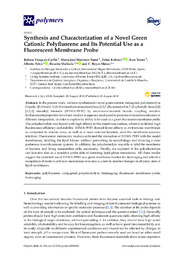Por favor, use este identificador para citar o enlazar este ítem:
https://hdl.handle.net/11000/30734Registro completo de metadatos
| Campo DC | Valor | Lengua/Idioma |
|---|---|---|
| dc.contributor.author | Vázquez Guilló, Rebeca | - |
| dc.contributor.author | Martínez Tomé, María José | - |
| dc.contributor.author | Kahveci, Zehra | - |
| dc.contributor.author | Torres, Iván | - |
| dc.contributor.author | Falcó, Alberto | - |
| dc.contributor.author | Mallavia, Ricardo | - |
| dc.contributor.author | Mateo , C. Reyes | - |
| dc.contributor.other | Departamentos de la UMH::Agroquímica y Medio Ambiente | es_ES |
| dc.date.accessioned | 2024-01-26T10:42:12Z | - |
| dc.date.available | 2024-01-26T10:42:12Z | - |
| dc.date.created | 2018-08-20 | - |
| dc.identifier.citation | Polymers 2018, 10, 938 | es_ES |
| dc.identifier.issn | 2073-4360 | - |
| dc.identifier.uri | https://hdl.handle.net/11000/30734 | - |
| dc.description.abstract | In the present work, we have synthesized a novel green-emitter conjugated polyelectrolyte Copoly-{[9,9-bis(60-N,N,N-trimethylammonium)hexyl]-2,7-(fluorene)-alt-4,7-(2-(phenyl) benzo[d] [1,2,3] triazole)} bromide (HTMA-PFBT) by microwave-assisted Suzuki coupling reaction. Its fluorescent properties have been studied in aqueous media and in presence of model membranes of different composition, in order to explore its ability to be used as a green fluorescent membrane probe. The polyelectrolyte was bound with high affinity to the membrane surface, where it exhibited high fluorescence efficiency and stability. HTMA-PFBT showed lower affinity to zwitterionic membranes as compared to anionic ones, as well as a more external location, near the membrane-aqueous interface. Fluorescence microscopy studies confirmed the interaction of HTMA-PFBT with the model membranes, labelling the lipid bilayer without perturbing its morphology and showing a clear preference towards anionic systems. In addition, the polyelectrolyte was able to label the membrane of bacteria and living mammalian cells, separately. Finally, we explored if the polyelectrolyte can function also as a sensitive probe able of detecting lipid-phase transitions. All these results suggest the potential use of HTMA-PFBT as a green membrane marker for bioimaging and selective recognition of bacteria cell over mammalian ones and as a tool to monitor changes in physical state of lipid membranes. | es_ES |
| dc.format | application/pdf | es_ES |
| dc.format.extent | 20 | es_ES |
| dc.language.iso | eng | es_ES |
| dc.publisher | MDPI | es_ES |
| dc.rights | info:eu-repo/semantics/openAccess | es_ES |
| dc.rights | Attribution-NonCommercial-NoDerivatives 4.0 Internacional | * |
| dc.rights.uri | http://creativecommons.org/licenses/by-nc-nd/4.0/ | * |
| dc.subject | polyfluorene | es_ES |
| dc.subject | conjugated polyelectrolyte | es_ES |
| dc.subject | bioimaging | es_ES |
| dc.subject | fluorescent membrane probe | es_ES |
| dc.subject | bioimaging | es_ES |
| dc.subject.classification | Química Física | es_ES |
| dc.subject.other | CDU::5 - Ciencias puras y naturales::54 - Química | es_ES |
| dc.title | Synthesis and Characterization of a Novel Green Cationic Polyfluorene and Its Potential Use as a Fluorescent Membrane Probe | es_ES |
| dc.type | info:eu-repo/semantics/article | es_ES |
| dc.relation.publisherversion | https://doi.org/10.3390/polym10090938 | es_ES |

Ver/Abrir:
polymers-10-00938-v2.pdf
2,85 MB
Adobe PDF
Compartir:
 La licencia se describe como: Atribución-NonComercial-NoDerivada 4.0 Internacional.
La licencia se describe como: Atribución-NonComercial-NoDerivada 4.0 Internacional.
.png)